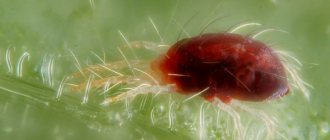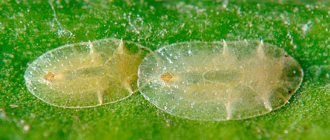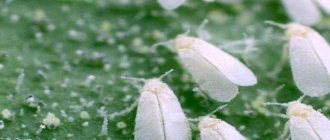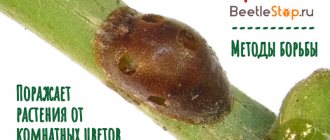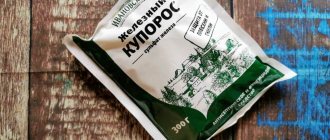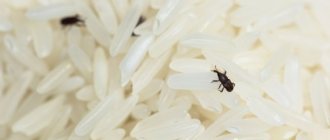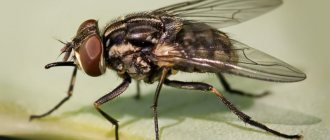Vegetable growing » Pepper
0
1595
Article rating
Kira Stoletova
Every gardener is concerned about the pest situation when growing vegetables. Even if a plant is disease-resistant, there is a possibility of infection. Aphids on peppers are a common sight in gardening. These insects suck the juice from vegetables, which slows down its growth.
Aphid on pepper
The cause of aphids is ants. They are carriers of pests. You can tell that a plant is infected with these insects by the condition of the leaves. They curl, dry out and fall off. The back side becomes sticky, and aphid larvae are visible on the surface. The fight is carried out using chemical and biological methods. Folk remedies will also help.
Signs of pepper damage in a greenhouse by aphids
It is difficult to detect the insect itself, since the aphid does not exceed 5 mm in size and at the same time has a greenish-transparent color. Thanks to this, it perfectly camouflages itself under the green parts of the plantings. There are also darker varieties - from brown to black.
There are a number of signs by which their presence can be determined:
- Stopping the growth of seedlings.
- Curled, yellowed or blackened leaves.
- Termination of ovary.
- Fruit deformation.
- General weakening of the entire plant.
If you start checking all the plantings, then by turning over the leaf plate, you can find a cluster of aphids in the form of small moving greenish or black dots.
Advice. Even if you have the slightest suspicion of pests in the garden, you should immediately inspect all the plants. This will allow control to begin at an early stage with less crop loss.
Damage caused
Aphids feed on plant sap. Gnawing through the pulp, it sucks out the liquid with all the beneficial substances necessary for the normal growth and development of the vegetable. Because of this, the plant gradually fades.
But this is not the only problem. As insects live, they secrete a special liquid - honeydew. It becomes a favorable environment for the development of sooty fungus on the plant, which makes the life of pepper doubly difficult.
Important! In greenhouse conditions, aphids undergo an incomplete, accelerated development cycle. Females remain wingless. This significantly speeds up the process of reproduction and spread of insects.
Why is it dangerous?
During fruiting, aphids damage the buds and they fall off. Adults and their larvae, sucking the juice, weaken the peppers. The sticky honeydew that covers the leaves interferes with the process of photosynthesis. It serves as a favorable environment for the proliferation of pathogenic fungi.
A large colony of aphids can leave a summer resident without a harvest. The development of peppers stops. Some of the ovaries fall off. The fruits do not fill, there are few of them, their shape is deformed. Any change in weather can cause illness. Without timely treatment, a pepper bush affected by aphids may die.
Rules for processing pepper in a greenhouse
Before you start figuring out how to fight aphids in a greenhouse, it’s worth understanding how they get there. Aphids are carried by soil, gardening tools, planting material or shoes. Therefore, it is important to regularly disinfect all of the above.
Processing Features
In the greenhouse, precautions are especially important: gloves, a respirator, closed shoes and clothing. It is better to carry out processing on a dry, but not hot day. High humidity can cause drugs to wash off from plants.
Biological methods of protection in a greenhouse are very effective. In a closed space, introduced insect predators manifest themselves most effectively.
Causes of the pest
Why does such an unpleasant attack occur? There are many reasons why there may be an invasion of aphids on pepper seedlings growing indoors. Most often the problem occurs in the background:
- Incorrect temperature conditions, too warm air in the room at night.
- Increased humidity of the root system.
- Using contaminated seed material or insufficiently treated soil for planting.
- Entry of adult insects through an open window or doorway of the greenhouse.
Pepper seedlings are most often grown indoors, on window sills, in a greenhouse or outdoors. Under these conditions, aphid infestations are observed due to the use of contaminated soil or seeds.
Important! To prevent the occurrence of such a problem, it is necessary to carefully select seed material for planting, as well as use high-quality soil.
melon aphid
Chemicals for aphids
Such methods should be resorted to only when the spread of pests is very strong and folk or biological remedies are ineffective. Chemicals are the most effective, but also the most harmful to humans and the plant itself.
Important! Before using any chemical, you must carefully read the instructions and follow them strictly, otherwise you can harm the plantings even more.
The most popular drugs:
- "Fufanon" is effective against most pests. The solution is made from 1 ampoule of the substance and a liter of water.
- "Aktara" is intended for processing at an early stage of the growing season. Forces aphids to refuse food, which is why the insects die within a day.
- "Karbofos" is a potent drug. It is prepared by dissolving a tablespoon of the substance in 10 liters of water.
- "Intavir" has an effect on many garden pests. 1 tablet dissolves in a bucket of water.
- "Actellik" is a drug with an intestinal-contact spectrum of action. 1 ampoule is designed for 10 sq. m area. Diluted in two liters of water.
Reference. Aphids quickly get used to certain chemicals and develop immunity to them. Therefore, if you made any mistakes during processing and were unable to get rid of all the individuals, it is better to change the product.
General tips and tricks
Since the greenhouse is an enclosed space, it is important to follow the following rules for aphid treatment:
Always use a respirator, goggles, and clothing that covers your body. Sprayed particles should not come into contact with human mucous membranes and skin.- Do not use chemicals that have expired. They can accumulate toxic substances that will be dangerous to the health of not only the owner of the greenhouse, but also those people who will consume the peppers.
- Read the instructions carefully and follow the dosages recommended by the manufacturer. An overabundance of insecticides is dangerous.
- Never mix chemical and biological agents to improve effectiveness.
- Be sure to cultivate the soil around the pepper, since the larvae can remain viable for a long time while in the soil.
- After all work has been completed, you need to ventilate the greenhouse.
The frequency of spraying is important. There is no need to think that a one-time treatment will protect the pepper for the entire fruiting period. The manufacturer indicates on the packaging exactly what period can be considered active and how often it is recommended to spray pepper with this product.
Do not rush to buy insecticides and do not use them as a preventive measure more than 1-2 times per season. Along with their benefits, they can also be dangerous to health, especially if the greenhouse feeds a family with small children. The means at hand are no less effective, but they are absolutely safe for health.
Biological methods of control
The biological method consists of mechanical removal of pests. To do this, they use insect predators, birds, or catch individuals themselves.
To lure birds to your site, you will need to place edible bait for them. Common tits and sparrows do an excellent job of killing aphids.
Insect predators include ladybugs, some wasps, hover flies and lacewings.
There are also a number of drugs that are sold in specialized stores. They infect pests rather than kill them outright like chemicals. Biological products do not have a negative effect on plants. The active components in them are waste products of fungi, bacteria and other microorganisms.
Most popular:
- "Trichopolus";
- "Fitoverm";
- "Jaguar";
- "Aktofit";
- "Entobacterin";
- "Arrow".
Prevention
Timely preventive measures, if not completely eliminated, will minimize the risk of aphids appearing on peppers in greenhouses.
Prevention consists of:
- in treating seeds before sowing;
- disinfection of soil in the greenhouse during the preparation of beds;
- creating normal conditions for growing seedlings;
- compliance with watering rules;
- planting sharp-smelling plants next to the peppers: onions, herbs, garlic.
In autumn and spring, before the start of the planting season, it is recommended to fumigate the greenhouse with a sulfur bomb. In summer, it is advisable to dust the soil in the beds with ash. Active control of ants will help prevent the appearance of aphids.
The natural enemies of aphids are wasps, ladybugs, and hoverflies, so you need to create conditions to attract them: plant lavender, calendula, basil, and mint.
Folk remedies
If the pest population in the greenhouse is small, it is best to start the fight by using traditional methods.
Here are a few proven methods:
- Plant onions and garlic around the perimeter of the greenhouse outside. Their smell repels aphids. You can stick garlic heads into the soil along the path inside.
- Dilute 2 cups of ash and 100 grams of soap solution in a bucket of water. Mix everything, strain and spray the peppers with the solution.
- Pour 500 g of spruce needles into 2 liters of water and leave for a week. Before use, dilute 40 ml of infusion with a liter of water.
- 1 tbsp. l. dilute soda and 40 g of laundry soap in 1 liter of water. Treat the plants immediately after preparing the composition.
- Brew 30 grams of mustard powder with 0.5 liters of water. Leave for 3 days. Before use, add enough water so that the total volume is 10 liters.
- 2 tbsp. l. dissolve ammonia in 10 liters of water with a small amount of soap solution. This solution has a strong effect on aphids, causing convulsions, burns of the mucous membrane and rapid death.
- A solution of ammonia in the same proportion as ammonia is also very effective.
In addition to the listed substances, vodka, vinegar, celandine, tobacco, birch tar, milk and iodine, boric acid and Coca-Cola have proven themselves to be good in the fight against aphids.
Reference. Laundry soap is used to improve the adhesion of the substance to the plant. It can be added to all solutions.
What varieties can be found on the vegetable?
Today, on average, five main types are known: nightshade, greenhouse, peach, green and black aphids. It should be noted that the last two insects are considered the most dangerous: they not only parasitize the plant and feed on its vital juices, but also produce a substance that is a nutrient medium for fungi.
Green
Green aphids settle in large colonies on young pepper seedlings. A distinctive feature of this species is its love for flowering shoots. That is, by the end of spring, insects climb onto the stems and leaves of the plant, but aphids begin their violent reproduction closer to the budding and fruiting phase. Until this time, it is difficult to notice them, since the main group of insects hides at the place where the leaf attaches to the stem.
Black
The black aphid, also known as the house aphid, is the smallest insect and a member of the family. Small, no more than 0.3 mm in size. It is common for black aphids to live on the stem and inside of young pepper leaves. Nutrition mainly comes from the nutritious juices of the plant, and the most important elements in the aphid diet are carbohydrates and proteins, broken down into amino acids.
Therefore, it is not at all surprising to notice this parasite on young shoots. In addition, during digestion, aphids secrete honeydew, which tastes sweet and attracts ants. Most often, these two types of insects work together, therefore, where aphids appear, ants will soon appear, and vice versa.
Peach
A small, oval-shaped insect. Larger than black aphids: size ranges from 1 to 2 mm. Like other species of this family, the peach aphid appears, reproduces and lays eggs on the inside of the pepper leaf, but differs in appearance - the insect’s body covers are colored in red and orange tones.
Greenhouse
The third largest aphid, its body length is from 2 to 3 mm. Externally, the insect more closely resembles the green variety, but the size characteristic turns out to be the decisive difference. The main feature of the greenhouse specimen is that it is extremely thermophilic. The favorite “nesting” place for this parasite is greenhouses, therefore, it will not spread to cultivated plants outside the greenhouse.
Nightshade
The largest insect of the entire family: average size 4 mm. The body of the nightshade aphid is covered with light green chitin, however, this pest is unlikely to differ from other species in its behavior.
Preventive measures
To avoid the appearance of aphids in your beds, you should adhere to the following rules:
- The ideal microclimate in a greenhouse for peppers is 85% humidity and air temperature 25 degrees.
- Regular ventilation.
- Constant feeding.
- Fumigation of a greenhouse with warm sulfur gas before planting plants.
- Disinfection of the greenhouse frame with bleach or potassium permanganate solution.
- Regular weed removal.
- Purchase planting material only from trusted manufacturers.
Reference. Plants that receive proper care have good immunity and, therefore, are more resistant to pests and various diseases.
Common Mistakes
Sometimes aphids appear on vegetable crops due to mistakes made by the gardener:
- It’s hot and humid in the greenhouse or at home;
- the temperature does not drop at night;
- crops are watered abundantly and often.
The main mistake of a gardener is neglecting preventive measures.
During watering, pepper seedlings are carefully inspected. Having noticed alarming signals - withering of the tops, shrinking and yellowing of the foliage, a whitish coating, the plant is isolated from other plantings. The soil is sprinkled with ash, the leaves are washed with warm water. They choose a method of struggle and begin health procedures. Timely assistance will support pepper seedlings and give hope for a bountiful harvest. To avoid hassle with seedlings, preventive measures are taken.
